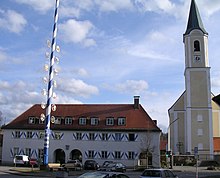Glonn
Glonn is a market town in the Ebersberg district in Upper Bavaria, Germany, about 30 km (19 mi) southeast of Munich.
The community of Glonn includes nine small villages: Adling, Balkham, Frauenreuth, Haslach, Mattenhofen, Kastenseeon, Reinstorf, Schlacht, Steinhausen and Wetterling.
Early settlement in the New Stone Age is witnessed by a number of finds, among them a dwelling pit, weapons and jewellery.
The town's name derives from the Celtic description of the local river Glana – "Clear".
In a donation document signed by the bishop of Freising on 21 March 774, Glonn is named as "Glan"; this is taken to be the earliest evidence of the town's founding.
From about 1015, it is known that there was a local lordly family called "da Glana", and in 1349, the building register Monumenta Boica mentioned the Church of St. Johann zu Glan.
After World War II Glonn was a refugee destination for those driven out of their homelands, those whose homes were bombed out and those who had been evacuated, and this new inflow of people eventually grew to become more than a third of the town's population.
Glonn's arms might heraldically be described thus: In argent a four-spoked waterwheel sable above which a trout azure finned Or.
The waterwheel and the trout refer to the area's wealth in water and the seven former cornmills that were so important to the local economy.
With the French village of Bonnefamille, contact was established in 1998 and led to alternating visits of clubs and delegations.
The goal of this unusual pairing is to be the dovetailing of regions in the northern and southern parts of the district that are otherwise split by the Ebersberg Forest.
The writer Lena Christ's home life may be glimpsed in a faithfully reconstructed room at the museum.
In 1825, the castle was bought by Bavarian Electress Maria Leopoldine, who was married to Count Ludwig of Arco.
On 14 September 1927 the castle was bought for 735,000 Reichsmarks by the Sisters of the Good Shepherd (Schwestern vom guten Hirten), who run it today as a residential school for girls from difficult social backgrounds.
After the Second World War broke out, the training building was confiscated as a reserve Wehrmacht field hospital.
It is built in the Rococo style and contains altar figures and a crucifix with Schmerzhafte Muttergottes ("Mater Dolorosa") by the artist Joseph Götsch (a student of Ignaz Günther).
This led to fierce protests by the girls' parents and in the end drew the Gestapo's attention when somebody put what is known locally as a Pfingstlümmel (a straw "Whitsun doll") on the neighbouring boys' school roof on Whitsunday.
The Galerie in der Klosterschule offers artists a platform for their work with regular thematic exhibitions.
The Steinbeißer ("Stonebiter"), as tall as a man and found on the way into town right next to the car dealership of the same name, comes from this workshop.
A basketball court is also open to the town's youth outside school hours, as are the two football pitches, each furnished with goals.
The scenic countryside around the town invites hikers and cyclists, and when there is enough snow, the winter sport club runs a well groomed cross-country ski loop.
On one Saturday in mid-July, visitors to the Nachtflohmarkt ("night flea market") throng through the main street, mostly by candlelight and lantern light.
The State Council Office (Landratsamt), the court (Amtsgericht), police headquarters and other authorities responsible for Glonn are in Ebersberg.
Ebersberg notaries each hold, as a rule, a monthly office day at Glonn's town hall.
The local health insurance company offers advice every month at the town hall.

